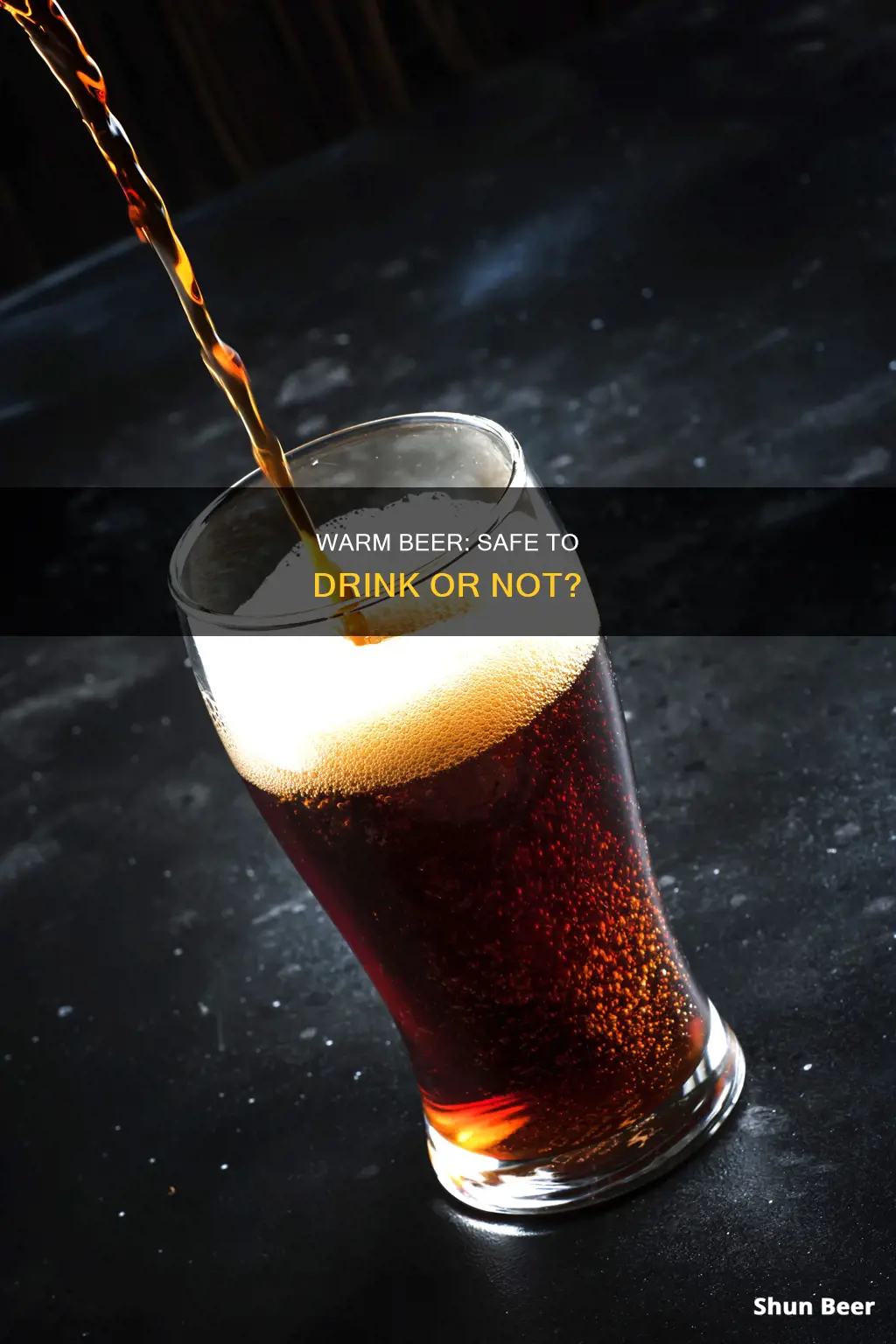
Drinking warm beer has been a common practice throughout history. In the days before refrigeration, people had no choice but to drink beer at ambient temperature or slightly cooled. In fact, during the 16th and 17th centuries, it was fashionable to drink mulled beer, which was heated and spiced. While the taste of warm beer may not be to everyone's liking, it is generally safe to consume. Exposure to warm temperatures can affect the flavour of beer, causing hop flavours and aromas to diminish and malt flavours to turn into a generic sweet taste. However, it will not make you sick.
What You'll Learn

Drinking warm beer is safe for your health
Drinking warm beer is perfectly safe for your health. In fact, for the majority of its history, beer has been consumed warm. From the dawn of civilisation until the advent of artificial refrigeration in the 19th century, warm was the only way to drink beer.
The belief that drinking warm beer is unsafe likely stems from the idea that temperature cycling "skunks" beer. However, this is just an old wives' tale. While temperature does affect beer, it is exposure to warm temperatures, not temperature cycling, that can impact its flavour. Beer is best preserved when kept cold, and its shelf life can be significantly reduced if kept at room temperature. However, even if warm beer doesn't taste as good, it can never make you sick.
In the days before refrigeration, warm beer was considered to have health benefits. From the early 1600s to the mid-1800s, warmed beer was a staple of tavern life, and drinkers were convinced it was good for them. It was believed that drinking cold beer would upset digestion and vaporous humours. Warm beer was considered an aid to healthy living, and spiced, heated beer was thought to help with digestion and respiratory issues.
So, while you may prefer your beer ice cold, rest assured that drinking it warm is perfectly safe and was, in fact, the preferred way to consume it for centuries.
Drinking and Driving: Is It Ever Safe?
You may want to see also

Beer tastes different when warm
When beer is very cold, the full flavours are masked or completely hidden. This is particularly true of malt flavours in beer. Many darker beers (stouts and porters) are usually served at cellar temperature because excess cold covers the primary flavour producer, the malt. For hoppier beers, the cold has less of an effect.
Lager beers are brewed at about 50 degrees Fahrenheit, and ale beers at about 70 degrees Fahrenheit, so lager beers tend to taste better at colder temperatures, and ales at slightly higher temperatures.
However, it is a myth that temperature cycling affects the taste of beer. Temperature swings will not "skunk" the beer. Beer is best preserved when kept cold, and keeping beer refrigerated will keep its flavour as the brewer intended for much longer. But temperature cycling will not ruin the beer.
Beer Belly Blues: Preventing Gas After Drinking Beer
You may want to see also

The myth of skunked beer
You may have heard that letting refrigerated beer get warm and then cooling it again will result in a skunky flavour. This is a myth. Moderate temperature fluctuations, like taking a beer out of the fridge, letting it sit for a few hours, and then putting it back in the fridge, will not impact the flavour of the beer.
The real culprit behind skunky beer is light, specifically ultraviolet (UV) rays. UV rays can cause the hop-derived molecules in beer to break down and merge with a sulphuric compound, resulting in an odour and flavour similar to that of a skunk and soggy cardboard, respectively. This is why skunked beers are also called "lightstruck".
It is a common misconception that it takes a lot of light to turn a beer skunky. In reality, only a few seconds of exposure to light is all it takes for the bittering iso-alpha acids from hops in the beer to trigger the production of skunk-smelling compound molecules (3-methyl but-2-ene-1-thiol or 3-MBT). Just four parts per trillion of 3-MBT can create a strong, noticeable odour.
Another myth is that some beers are meant to taste skunky. While a small percentage of craft brewers believe that a hint of skunk odour in saisons stored in clear or green bottles is true to the style's origins, in reality, skunked beers are considered flawed, and no brewer wants their beer to smell or taste that way.
So, the next time you're worried about your beer getting warm, remember that it's not the temperature fluctuations that will skunk your beer, but rather exposure to light. Keep your beer out of direct sunlight and store it in brown-tinted bottles to prevent it from becoming lightstruck.
Beer and Heart Failure: What You Need to Know
You may want to see also

Beer is best preserved when kept cold
Keeping beer refrigerated helps maintain its flavour as intended by the brewer. Storing beer at room temperature can drastically reduce its shelf life, from nearly six months to only a few weeks. Exposing the same beer to very warm temperatures can impact its flavour within a couple of days.
The effects of heat on beer are similar to those on milk. A gallon of milk will last much longer in a refrigerator than on a kitchen counter. Beer, like milk, is best preserved when kept cold.
While temperature cycling does not "skunk" beer, as is commonly believed, temperature does have an impact on beer. Beer flavour changes over time, and this process is accelerated at higher temperatures. Hops fade away, and oxidation occurs more rapidly at warmer temperatures than at colder ones.
In summary, while it is safe to drink warm beer, keeping it refrigerated will preserve its flavour and freshness for a longer period of time.
Drinking Beer on Florida Beaches: What's the Legal Verdict?
You may want to see also

Heating beer was once considered necessary
The preference for warm beer was also due to the absence of refrigeration. During the summer months, beer was stored in cellars to keep it cool, but it was still served at a temperature that would be considered warm by modern standards. In the winter, warm beer was welcomed as a pleasant and comforting distraction from the cold.
The dominance of homebrewing was another factor that made heating beer necessary. The use of substandard ingredients, questionable equipment, and brewing techniques often resulted in unpalatable beer. Adding spices and heating the beer increased its appeal and improved the taste.
The practice of drinking warm beer was also influenced by cultural norms and conventions. In Europe, it was common to drink beer at room temperature, and settlers brought this tradition with them to colonial shores.
During the 19th century, the introduction of lager beer and artificial refrigeration led to a shift in preferences towards cold beer. However, the tradition of drinking warm beer, especially during the colder months, continues to have its allure, with some bars and breweries offering hot beer options.
Drinking Beer While Driving in New Zealand: What's Allowed?
You may want to see also
Frequently asked questions
Yes, it is safe to drink warm beer. While exposure to warm temperatures can affect a beer's flavour, it will not make you sick.
Beer is best preserved when kept cold. Keeping beer refrigerated will help maintain its flavour for longer. Keeping beer at room temperature can reduce its shelf life from nearly six months to only a few weeks, and exposing it to very warm temperatures can affect its flavour in a matter of days.
If you're camping near a stream, you can store your beer in the water to keep it cool. Alternatively, you can dig a hole and place your beer inside to keep it cool. Wrapping a wet sheet of newspaper around a warm beer and leaving it in a breezy area can also help cool it down.
Ales are traditionally served warmer than pilsners, so these may be a good option if you're looking for a beer to drink at room temperature. Sweetness in beer generally becomes stronger when the beer is warmer, so you may want to opt for a beer with a bit of sour to balance out the flavours.







